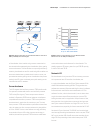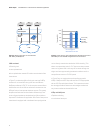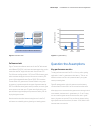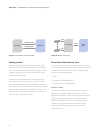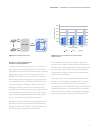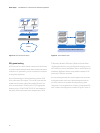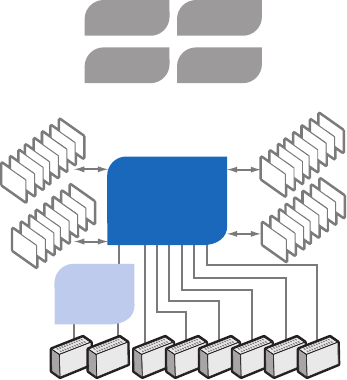
Problem statement
ESL’s perception, along with that of many of its peers in the
gaming industry, was that gaming servers “can’t be virtualized”
due to their mission-critical nature, high CPU utilization, and
the critical focus of their user base on the in-game transaction
latency. However, ESL was very motivated to try to break through
this “perception barrier” because it has been experiencing expo-
nential growth for the past eight years, which caused substantial
problems for its IT team in managing game server sprawl, costs,
power, and operational expenses. The fundamental question
was: could we deliver the benefits of virtualization for the
gaming server infrastructure while maintaining high quality
of service (QoS) levels as perceived by the ESL members? The
virtualized game servers must deliver smooth game play and
measurably competitive in-game transaction latencies to be
acceptable to ESL’s customers.
New Technologies Allow
Us to Virtualize More
Our perceptions are shaped by our experiences and our knowl-
edge of the experiences of others. These perceptions often
become embedded in our thinking and need to be periodically
challenged to be sure that they still represent reality. As tech-
nology marches on, we have seen many IT perceptions change.
With this in mind, and with consideration of the latest technology
innovations that may be relevant to the problem at hand, ESL and
Intel proceeded to examine our perceptions about the virtualiza-
tion of gaming servers.
ESL Proof of Concept (PoC) overview
We know that servers grow more powerful with each new
generation, which improves the performance of any application
running on them, including virtualized ones. However, we also
know that virtualization overheads are especially severe for
I/O performance-sensitive applications such as this one, where
in-game transaction latency (which includes the round-trip
network latency) is so critical.
Our hypothesis was that virtualization of gaming servers may be
possible if we use the latest technologies:
•IntelXeonprocessor7400-basedserverswith24processing
cores to address the need for higher performance overall. This
should allow us to deliver QoS headroom to counteract the over-
heads of virtualization. This platform was also chosen due to the
desire for high consolidation ratios to address ESL challenges
with server sprawl, cost, power, and operational expenses.
•IntelNICswiththeVMDqfeature.whichallowthevirtualized
network overheads to be minimized and the network load to be
spread across multiple platform cores for higher performance
and more headroom to maintain QoS.
•VMwareESX3.5*tosupporttheplatformchosen.ESX3.5also
delivers substantial networking performance improvements
compared to earlier versions.
•VMwareNetQueuefeature,whichprovidesthesoftwareenviron-
ment to take advantage of the VMDq feature in the latest NICs.
We could not find any industry data on the latency impact of
virtualization that was relevant to typical gaming server proto-
cols, so we decided to first test the network-latency impact
7400 Series
Intel Xeon
Intel Xeon
Intel Xeon
Intel Xeon
4 sockets with 6 cores
4x
1066
Intel Xeon
processor 7300
series
ESB2
I/O Bridge
Configurable PCI Express*
32 Slots
• 256 GB maximum
• 32 GB as tested
Figure 2. Intel® Xeon® processor 7300 platform
high-level architecture.
4
White Paper Consolidation of a Performance-Sensitive Application







